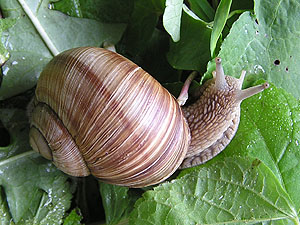
Roman snail, Helix pomatia. [RN]

Prickly cockle, Acanthocardia echinata.

Common cuttlefish, Sepia officinalis.
Picture: Robert Patzner, Salzburg University.
 Roman snail, Helix pomatia. [RN] |
|
 Prickly cockle, Acanthocardia echinata. |
|
 Common cuttlefish, Sepia officinalis. Picture: Robert Patzner, Salzburg University. |
|
A Roman snail, a cockle and a cuttlefish, on first sight, seem not to have too much in common, except all three of them may be found on man's menu's. Humans have been eating mussels and clams since the Palaeolithic, as can be proved by the so-called "Křkkenmřddinger". Those palaeolithic heaps of mussel shells have been excavated at the sites of human settlement near the coast. In a similar way Roman snail shells have been found at Roman excavation sites (hence the snail's name!).
But looking at the external appearance of all three animals from a biologist's eye, they all appear rather different. All three have a hard calcareous outer shell. But the snail's shell is coiled like a spiral (see: "The Way Snail Shells Are Coiled"), the cockle has got two shell valves (hence "Bivalvia") and the cuttlefish, finally even has got an internal shell, the cuttlebone.
Also the body's outer appearance seems very different in the three animals: The snail has got an elongate body and crawls on its belly (hence "Gastropoda"), and its head bears four tentacles. The cockle does not seem to move at all. Neither does it seem to have any head, though sometimes a tongue-like part of its body can be seen looking out between the shell valves. The cuttlefish finally has got a flat body with lateral fins, a head with large eyes and ten tentacles, two very long ones and eight short ones, with suckers.
Finally, also the ways of living of all three are very different. The Roman snail lives on dry land and eats plants. The cockle lives in the sea near the coast and lives on plankton, which it filters from the water. The cuttlefish finally is a lurking predator, that waits concealed and camouflaged between water plants and mainly eats crabs.
|
|
|
|
Cuvier's embranchements:
• Radiata: e.g. Jellyfish. • Articulata: e.g. Insects, crabs, spiders. • Mollusca: Molluscs. • Vertebrata: e.g. Fish, mammals, birds. |
In spite of all those differences biology assembles all three animal species to one common larger group, a so-called phylum, that is called molluscs. The Swedish naturalist Linné, when he wrote the first version of his Systema naturae in 1735, had the similarities, that are the basis for the mollusc phylum.
Merits for this achievement are to go to the French naturalist Georges Cuvier, who in 1795 described the molluscs as one of four large groups (embranchements) of animals.
The division criterion which he applied in building his system was comparative anatomy, the field of science he was working in as a professor in Paris. That was also why he recognised that snails, cockles and cuttlefish may look different externally, but that they shared a common design.
Mollusca, the scientific name applied since then means "soft animals", molluscs lacking any form of skeleton (mollis means soft in Latin). The field of science, though, dealing with molluscs, is malacology (malakos meaning soft in Greek).
Today we know, that the different composition of molluscs' bodies is a result of more than 500 million years of evolution that adapted molluscs to almost all habitats in the world. The first mollusc fossils known to science are from the Cambrian, 600 million years ago.
Today the phylum of Mollusca is divided into eight different classes, six of which are exclusive marine (living in the sea). Only bivalves and gastropods have been able to adapt to life in fresh water (bivalves and gastropods) and land (only gastropods, of all molluscs).
It is assumed today, that all molluscs' ancestor (referred to generally as Hypothetical Ancestral Mollusc) was an animal living on the ocean floor. There was a difference between those first molluscs' upper side (called the dorsal side) which was unprotected against the surrounding sea, and its lower side (the ventral side) that served locomotion and needed not to be protected. While the ventral side of the mollusc evolved into a foot to crawl over the ocean floor, on the dorsal side developed a protective shell. This led to the body composition plan basically typical for all molluscs.
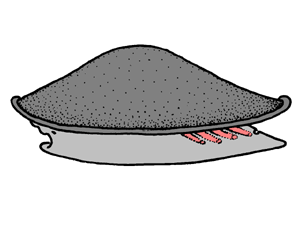 Sketch of a primordial mollusc. Dark grey: Shell; light grey: Foot; light red: Gill threads. Source: Livingstone, Biodidac. |
The mollusc phylum is different from all other animals in some typical characters, which are basically present in all classes, but which may be reduced at a later point in evolution:
![]() Mollusc
morphology: Characteristic features of mollusc morphology.
Mollusc
morphology: Characteristic features of mollusc morphology.
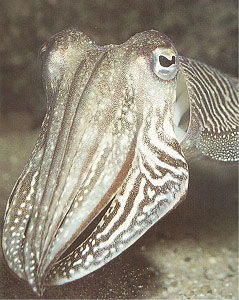
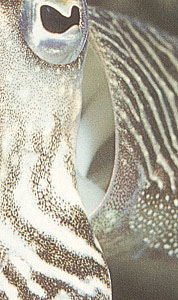 Common cuttlefish (Sepia officinalis). On the right: Pallial cavity enlarged. |
Besides the importance of many mollusc species as human food, mollusc have also often been used as basis for the manufacture of colours, tools and weapons. For example the colour purple as status symbol to distinguish the Roman senator from his fellow citizens, was made from tens of thousands of sea shells, which produced it from a tiny gill-side gland. Of course, such colours are produced synthetically today, otherwise by today purple shells would surely be extinct.
![]() Molluscs in Trade
and Tools.
Molluscs in Trade
and Tools.
The close connection of many coast-dwelling peoples is shown in the frequent appearance of molluscs or mollusc-like motives in art and architecture. For example the geometrically regular shell of a Nautilus has often been used to manufacture pieces of art, but it also has served as a basis for many spiral-type motives in art. So have the spirals of snail shells.
Mussels' and oysters' pearls have been important to the manufacture of jewellery for millennia, and has the mother-of-pearl, the innermost layer of a pearl mussel or oyster. Cowry shells have been a substitute for money in Africa, even after the introduction of "real" money until in the 1960's. No wonder a cowry species is called Monetaria moneta ("moneta" meaning "coin" in Latin).
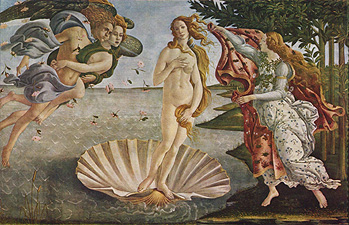 "The Birth of Venus" (Botticelli, 1482). Picture: Wikipedia. |
At the end of the Middle Ages, with lots of new discoveries, besides simply depicting the colourful shells from far away lands, there came a new task: Collecting them. Natural cabinets which apart from shells also contained minerals and other natural specimens, began to appear in the Renaissance period and found their culmination point in the Victorian era, when almost every wealthy household had one.
From some of those natural cabinets developed today's natural history museums and scientific collections, which are the basis of mollusc systematics and luckily found in every larger city.
![]() From
a Collection to the Museum: The development of private and public
collections and their importance to scientific work.
From
a Collection to the Museum: The development of private and public
collections and their importance to scientific work.
So today most reputable natural history museums have got a basic Mollusc collection, usually with a Mollusc department with a more or less vast library. In Europe the generally accepted main authority in the field of Malacology is the Senckenberg-Museum in Frankfurt am Main, especially in form of the German Malacological Society (DMG) based in that museum. Other museums in the German language area with important malacological collections are the Natural History Museum in Vienna (Austria), the Löwentor Museum in Stuttgart and the Haus der Natur in Cismar.
In Britain it is, for example, the Royal Natural History Museum in London and the Malacological Society of London.![]() Museums and Institutes
with malacological collections.
Museums and Institutes
with malacological collections.
Scientific magazines, usually published by the large malacological societies, publish the latest scientific discoveries in the field of malacology.
Of course it is not only the museums who do malacological field work. A large and probably the most important part of work is done by the many private scientists and mollusc enthusiasts all over the world, especially concerning mollusc life in a special region of the earth.